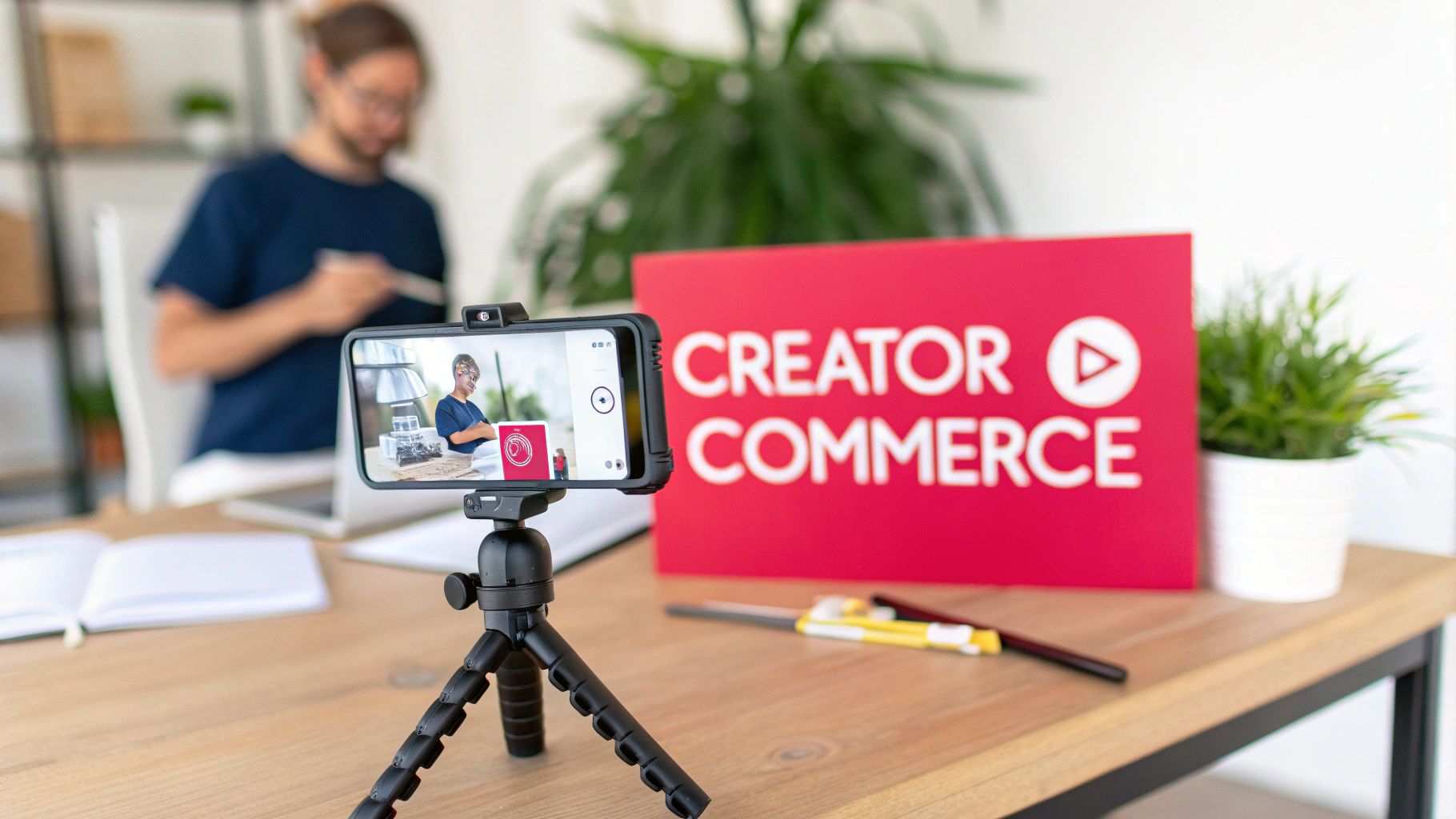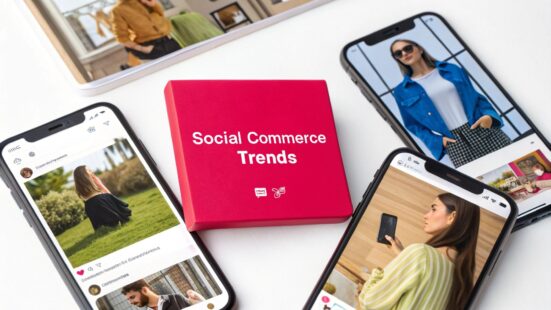 How to Sell Products on TikTok in 2024
How to Sell Products on TikTok in 2024
Social media is no longer just a place for connection; it's the new digital mall. The lines between social scrolling and online shopping have completely blurred, creating a dynamic, integrated marketplace where discovery and purchase happen in the same feed. For brands, this shift represents a monumental opportunity to meet customers where they are, creating seamless and highly personalized buying journeys directly within their favorite apps. The path from a user’s “like” to a completed sale is now shorter and more direct than ever before.
Understanding and adapting to the latest social commerce trends is no longer optional; it is essential for driving growth and building brand loyalty. Consumers now expect to shop within the context of their social interactions, influenced by creators, friends, and authentic user-generated content. This evolution demands a strategic pivot from traditional e-commerce tactics to a more community-centric and interactive approach.
This comprehensive guide dives deep into the 10 pivotal social commerce trends that are shaping the future of digital retail. We will move beyond surface-level observations to provide you with a strategic roadmap. For each trend, you will find:
- Actionable insights to integrate the trend into your marketing stack.
- Practical implementation details for immediate application.
- Real-world brand examples to inspire your next campaign.
From the immersive power of AR try-ons and the viral potential of TikTok Commerce to the authentic influence of creator-led campaigns and the efficiency of native checkouts, mastering these trends is critical. This listicle is designed to equip marketers, brand managers, and founders with the knowledge needed to stay competitive and drive measurable revenue growth in this new era of retail.
Table of Contents
1. Shoppable Posts and Live Shopping
One of the most foundational and rapidly evolving social commerce trends is the integration of direct purchasing capabilities into everyday content. Shoppable posts and live shopping events effectively transform passive scrolling into an active, seamless shopping journey, collapsing the traditional marketing funnel by allowing consumers to purchase products directly within their social media feeds. This immediacy reduces friction and capitalizes on the "in-the-moment" desire that social content creates.
Platforms like Instagram and TikTok have mastered this by embedding product tags directly into images, videos, and Reels. A user can tap a tagged item in a post to view its details and price, then proceed to checkout without ever leaving the app. This creates an uninterrupted user experience that feels native to the platform.
The Rise of Interactive Live Commerce
Live shopping takes this a step further, merging entertainment with e-commerce. It's a modern, digital version of a home shopping network, where hosts demonstrate products in real-time, answer questions from the audience, and create a sense of urgency and community. This format is particularly effective for products that benefit from demonstration, such as cosmetics, apparel, and electronics. Beauty brand Sephora, for example, regularly uses live events to launch new products, featuring makeup artists who showcase application techniques and interact directly with viewers, driving both engagement and sales.
Key Insight: The power of live shopping lies in its authenticity and interactivity. Viewers feel more connected to the brand and more confident in their purchase decisions after seeing a product used by a real person and having their questions answered on the spot.
Actionable Strategies for Implementation
To leverage this powerful trend, brands should:
- Optimize Product Catalogs: Ensure your product catalogs are correctly synced with platforms like Facebook, Instagram, and TikTok Shop. Use high-quality imagery and detailed, keyword-rich descriptions.
- Promote Live Events: Announce live shopping events well in advance across all channels. Use countdown timers in Stories and create teaser content to build anticipation.
- Offer Exclusive Incentives: Drive attendance and conversion by offering limited-time discounts or exclusive product bundles available only to live viewers.
- Repurpose Live Content: After the event, save the video and share clips as Reels, Stories, or TikToks, tagging the featured products to extend the content's shoppable lifespan.
2. Influencer and Creator Commerce
Another powerful social commerce trend is the strategic partnership between brands and creators, which transforms trusted recommendations into direct revenue streams. Influencer and creator commerce moves beyond simple endorsements, involving deep collaborations where creators co-develop product lines, curate collections, or integrate affiliate links directly into their content. This approach leverages the authentic connection creators have with their audience, turning their influence into a tangible sales channel.

This model thrives because it feels less like an advertisement and more like a genuine suggestion from a trusted source. When creators like Charli D'Amelio or Addison Rae launch collaborative product lines, their followers are already primed to purchase. The trust has been pre-established, significantly lowering the barrier to conversion and making the path from discovery to checkout incredibly short.
Leveraging Authenticity for Sales
The core of creator commerce is authenticity. Consumers are increasingly skeptical of traditional advertising, but they place immense trust in the creators they follow. By partnering with influencers whose values and audience demographics align with their own, brands can tap into highly engaged, niche communities. This strategy is particularly effective for direct-to-consumer (DTC) brands aiming to build brand loyalty and drive repeat purchases. Fashion Nova, for instance, built its empire by collaborating with a vast network of fashion influencers, effectively turning Instagram into its primary storefront.
Key Insight: Creator commerce is most effective when it is a long-term, authentic partnership. One-off sponsored posts can raise awareness, but sustained collaborations that give creators genuine input are what build lasting brand affinity and drive consistent sales.
Actionable Strategies for Implementation
To build a successful creator commerce program, brands should:
- Partner with Aligned Creators: Prioritize partnering with creators, including micro-influencers (10K-100K followers), whose personal brand and audience genuinely match your product. To effectively navigate this landscape, explore successful top influencer marketing campaign examples.
- Empower Creative Freedom: Provide creators with clear guidelines but allow them the creative freedom to promote products in their unique voice. This ensures the content feels natural and resonates with their audience.
- Utilize Affiliate and Commission Tools: Equip creators with unique affiliate links and promo codes through platforms like TikTok Shop. This not only incentivizes them but also provides clear, trackable data on their sales performance.
- Build Long-Term Relationships: Focus on developing ongoing partnerships rather than single campaigns. This fosters deeper loyalty from both the creator and their audience, leading to more sustainable results.
3. Social Storefronts and Native Checkout
Beyond individual shoppable posts, a major evolution in social commerce trends is the emergence of fully integrated social storefronts. These are dedicated, brand-curated shopping destinations directly within social media platforms. The most critical component of this trend is native checkout, which allows customers to complete their entire purchase, from discovery to payment, without ever leaving the app. This creates a frictionless path to purchase, drastically reducing cart abandonment rates caused by redirecting to external websites.
Platforms like Instagram and Facebook Shops have pioneered this, enabling brands to build and customize a digital storefront that mirrors their e-commerce site. A user can browse collections, view detailed product pages, and save items, creating a cohesive and contained shopping experience. This transforms a brand's social profile from a simple content feed into a powerful, always-on sales channel.

Creating a Seamless Retail Environment
Social storefronts excel at centralizing a brand's product catalog in the place where audiences are most engaged. Instead of relying on a single "link in bio," brands can tag products across their content, all leading back to this centralized, in-app shop. Fashion brand Zara, for instance, uses its Instagram Shop to showcase complete, styled looks, allowing users to easily browse and purchase every item featured in an image directly from their storefront. This not only simplifies the buying process but also enhances product discovery.
Key Insight: The primary advantage of social storefronts with native checkout is the elimination of friction. By keeping the entire journey within a trusted, familiar app, brands capitalize on impulse buying behavior and significantly improve conversion rates.
Actionable Strategies for Implementation
To build an effective social storefront, brands should:
- Curate Product Collections: Organize your storefront into logical collections like "New Arrivals," "Best Sellers," or seasonal themes to guide the shopping experience.
- Optimize Product Details: Use high-resolution, mobile-first imagery and write concise, compelling product descriptions. Integrate customer reviews and ratings directly on product pages to build trust.
- Ensure Inventory Sync: Use platform integrations (like with Shopify or BigCommerce) to keep inventory levels and pricing accurate in real-time, preventing customer frustration.
- Promote Your Shop: Regularly direct followers to your storefront through Stories, Reels, and in-feed posts. Use calls-to-action like "Shop the Collection" or "Tap to View Shop."
4. User-Generated Content (UGC) Commerce
One of the most powerful social commerce trends is the strategic integration of user-generated content (UGC) directly into the shopping experience. This approach involves brands encouraging their customers to create and share content featuring their products, which is then repurposed to serve as authentic marketing collateral. By turning customers into brand advocates, UGC builds unparalleled social proof and fosters a strong sense of community, making marketing feel less like an advertisement and more like a trusted recommendation from a friend.
This trend capitalizes on the reality that modern consumers trust peer reviews far more than branded messages. When a potential buyer sees a real person enjoying a product in a real-world setting, it creates a powerful, relatable connection that polished ad campaigns often struggle to achieve. Brands like GoPro have built their entire marketing ethos around this, using stunning customer-shot adventure videos to showcase their camera's capabilities in a way that is both aspirational and authentic.
Leveraging Authenticity for Conversion
The primary function of UGC in commerce is to provide genuine social proof at critical points in the customer journey. This content can be featured directly on product detail pages, in social media feeds, and in targeted ads. For example, beauty brand Glossier's #Glossierette campaign encourages users to share their makeup looks, creating a vast, searchable library of authentic product demonstrations on a diverse range of skin tones and types. This not only boosts engagement but also helps new customers visualize how the products will look on them, directly influencing purchase decisions.
Key Insight: UGC transforms marketing from a monologue into a dialogue. It validates a customer's purchase decision by showing them a community of satisfied users, effectively reducing buyer hesitation and increasing conversion rates through authentic, peer-driven endorsements.
Actionable Strategies for Implementation
To effectively harness UGC for commerce, brands should:
- Launch a Branded Hashtag: Create a simple, memorable, and unique hashtag for your brand (e.g., #GoProHERO, #OptOutside) and promote it across all customer touchpoints.
- Incentivize Creation: Encourage submissions by running contests, offering discounts for shared content, or featuring top creators on your official channels. Make sure your legal permissions for using the content are clear from the outset. For a deeper dive into this, you can explore more about user-generated content strategies on joinbrands.com.
- Integrate UGC into Product Pages: Use tools and widgets to pull in tagged Instagram photos or TikTok videos directly onto the corresponding product pages, providing immediate social proof where it matters most.
- Amplify and Engage: Always credit original creators when you repost their content. Actively engage with the content by liking, commenting, and sharing to foster a sense of community and encourage more participation.
5. Conversational Commerce (Chatbots and Messaging Apps)
A pivotal social commerce trend moving beyond public feeds and into private channels is conversational commerce. This involves using messaging apps like Facebook Messenger, WhatsApp, and Instagram DMs, often powered by AI-driven chatbots, to guide customers through their shopping journey. It transforms the transactional nature of e-commerce into a personalized, one-to-one dialogue, offering everything from product recommendations to post-purchase support.
This approach meets customers where they are already spending their time: in messaging apps. Instead of navigating a website, a consumer can simply start a chat, ask questions about a product, receive tailored suggestions, and complete their purchase directly within the conversation. It creates a frictionless, concierge-like experience that builds customer loyalty and streamlines the path to conversion.
The Power of Personalized, Automated Dialogue
Conversational commerce excels at providing instant, 24/7 customer service and personalized shopping assistance at scale. Brands like Sephora leverage WhatsApp to connect customers with beauty advisors for personalized consultations and product recommendations. Similarly, Domino's famous chatbot on Facebook Messenger allows users to reorder their favorite pizza with a simple message, turning a routine purchase into a swift, effortless interaction.
Key Insight: The strength of conversational commerce lies in its ability to combine the immediacy and scale of automation with the personalized touch of a one-on-one conversation. This blend makes the shopping experience feel both efficient and uniquely tailored to the individual customer.
Actionable Strategies for Implementation
To effectively integrate conversational commerce, brands should:
- Design Natural Conversational Flows: Map out customer journeys and script chatbot interactions that feel human and helpful, not robotic. Start with common FAQs and build complexity over time.
- Ensure a Seamless Human Handoff: Program chatbots to recognize when a query is too complex and create a smooth, clearly defined process for transferring the conversation to a live agent.
- Integrate with Your E-commerce Stack: Connect your chatbot to your inventory and CRM systems. This allows it to provide real-time stock availability and use past purchase data to offer relevant product suggestions.
- Use Chat for Proactive Engagement: Go beyond reactive support. Use messaging to send order updates, abandoned cart reminders, and exclusive offers to customers who have opted in.
6. Group Buying and Social Shopping Events
Harnessing the power of community, another major social commerce trend is the rise of group buying and social shopping events. This model incentivizes collective purchasing by offering better prices or exclusive access when a certain number of people commit to buying an item. It transforms shopping from a solitary activity into a collaborative, community-driven experience, leveraging social proof and the fear of missing out (FOMO) to accelerate conversions.
Pioneered by platforms like Pinduoduo in China, this approach encourages users to share deals with their social networks to form buying groups and unlock lower prices. This user-driven marketing creates a viral loop, rapidly expanding a brand's reach while driving significant sales volume in a short period. The model is especially effective for CPG products, fast fashion, and electronics where bulk discounts are feasible.
The Urgency of Limited-Time Events
A key component of this trend is the use of timed events, such as flash sales or limited product drops, often popularized by streetwear brands like Supreme. These events create an intense sense of urgency and exclusivity, prompting immediate action. Amazon’s Lightning Deals operate on a similar principle, using countdown timers and visible stock levels to encourage quick purchase decisions. This format creates an event-like atmosphere that generates excitement and social chatter well before the sale even begins.
Key Insight: Group buying turns customers into active brand advocates. By requiring them to recruit others to secure a deal, you embed a powerful, organic marketing engine directly into the purchasing process, significantly lowering customer acquisition costs.
Actionable Strategies for Implementation
To effectively launch social shopping events, brands should:
- Offer Tiered Group Discounts: Structure deals so that the price drops as more people join the buying group. This gamifies the experience and motivates participants to share the offer widely.
- Create Urgency with Timers and Stock Limits: Clearly display countdown clocks and limited inventory ("only 50 left at this price!") on your social posts and product pages to drive immediate action.
- Promote Events Extensively: Announce your group buying events or flash sales in advance across all social channels, email lists, and push notifications to build anticipation and maximize participation.
- Prepare for Demand Spikes: Ensure your inventory management and customer service teams are ready for a sudden influx of orders and inquiries to maintain a positive customer experience.
7. Personalization and AI-Driven Recommendations
As social platforms become increasingly saturated with products, generic marketing is no longer effective. This is why personalization powered by artificial intelligence has emerged as one of the most critical social commerce trends. Advanced AI and machine learning algorithms analyze user behavior, browsing patterns, and past purchases to deliver highly relevant product recommendations directly within social feeds, creating a bespoke shopping experience for every individual.
This technology moves beyond basic targeting to offer a truly curated journey. For instance, after a user engages with a post about running shoes, AI can then populate their feed with shoppable content featuring complementary products like performance socks or running apparel. This creates a hyper-relevant experience that feels less like an ad and more like a personal shopping assistant, significantly boosting engagement and conversion rates.
The Power of Predictive Curation
The real advantage of AI-driven personalization is its ability to be predictive. By analyzing vast datasets, algorithms can anticipate a customer's future needs before they even search for a product. Subscription box service Stitch Fix exemplifies this by using AI to select clothing items based on a user's style profile and feedback, creating a "discovery" experience. Similarly, Pinterest’s visual search and recommendation engine surfaces products a user is likely to love based on their pins and browsing history, driving serendipitous purchases.
Key Insight: Effective personalization makes the customer feel seen and understood. When product recommendations align perfectly with a user's tastes and recent activities, it builds brand trust and transforms a one-time buyer into a loyal advocate.
Actionable Strategies for Implementation
To integrate this powerful trend into your social commerce strategy, brands should:
- Prioritize First-Party Data: Focus on collecting and leveraging first-party data from your website, app, and social media interactions. This data is invaluable for training AI models to understand your specific audience.
- Segment Audiences Dynamically: Use AI tools to create dynamic audience segments that update in real-time based on user behavior, allowing for more precise and timely ad targeting and content delivery.
- Test Recommendation Logic: Continuously A/B test different recommendation algorithms. For example, test a "Frequently Bought Together" model against a "You Might Also Like" model to see which drives higher average order values. For more insights into this, you can learn more about how predictive analytics can elevate marketing.
- Be Transparent and Offer Control: Clearly communicate how you use data to personalize experiences and give users options to customize their preferences. This transparency builds trust and improves the accuracy of recommendations.
8. Augmented Reality (AR) Try-On and Virtual Shopping
One of the most immersive social commerce trends, augmented reality (AR) technology, bridges the critical gap between digital browsing and physical product interaction. AR try-on features allow consumers to superimpose products onto their own image or environment using their smartphone camera, effectively creating a virtual showroom. This technology dramatically boosts purchase confidence for items like makeup, eyewear, and apparel by answering the crucial question: "How will this look on me?"

Platforms like Snapchat and Instagram have become leaders in this space, integrating AR filters that brands can use for marketing. For instance, MAC Cosmetics uses AR filters to let users instantly try on different lipstick shades, while Warby Parker's app allows customers to see how various eyeglass frames fit their face. This interactive experience not only engages users but also significantly reduces hesitation and lowers product return rates.
The Power of Virtual Visualization
AR extends beyond personal accessories to home goods. The IKEA Place app is a prime example, enabling users to virtually place true-to-scale 3D furniture models in their own rooms. This visualization removes the guesswork from online furniture shopping, helping customers make more informed decisions. As consumers increasingly look for ways to visualize products before purchase, innovations like virtual fitting room technology are becoming essential for a seamless social commerce experience.
Key Insight: AR try-on isn't just a novelty; it’s a powerful conversion tool. It addresses a core friction point in e-commerce by providing a personalized, tangible preview that static images and videos cannot match, directly influencing buying decisions.
Actionable Strategies for Implementation
To integrate AR into your social commerce strategy, brands should:
- Partner with AR Platforms: Utilize the built-in AR creation tools on platforms like Snapchat (Lens Studio) and Instagram (Spark AR) to develop branded filters and try-on experiences.
- Ensure High-Fidelity Models: Invest in creating accurate, high-quality 3D models of your products. The realism of the AR experience is crucial for building trust and driving conversions.
- Promote Your AR Filters: Actively promote your AR lenses and filters through influencer campaigns, paid ads, and QR codes on physical packaging to encourage user adoption.
- Integrate with Product Pages: Connect your AR experience directly to the corresponding product pages, allowing users to move seamlessly from "trying on" to "adding to cart."
9. Social Subscription and Loyalty Programs
Beyond one-time transactions, one of the most powerful social commerce trends is the integration of recurring revenue models through subscriptions and loyalty programs. This approach shifts the focus from customer acquisition to long-term retention, transforming social media platforms into hubs for building and rewarding dedicated brand communities. By offering exclusive value, brands can cultivate a loyal following that generates predictable income.
Platforms like Patreon pioneered this model for creators, but e-commerce brands are now adapting it to offer premium content, early access to products, or exclusive community features. For example, a brand might use a private Instagram or Discord channel for subscribers, offering them first looks at new collections or direct interaction with designers. This creates a powerful sense of belonging and exclusivity that drives both loyalty and recurring sales.
Building Community Through Exclusive Access
The core of this trend is leveraging social platforms to deliver ongoing value that justifies a recurring payment or continued loyalty. It’s about building a club that people want to be a part of. Amazon successfully integrates its Prime membership with social channels by offering exclusive deals during live shopping events on platforms like Twitch. Similarly, a beauty brand could create a tiered loyalty program where members unlock exclusive tutorials, Q&A sessions with experts, or even personalized product recommendations based on their engagement and purchase history.
Key Insight: Social subscriptions and loyalty programs succeed by treating customers like insiders. The value isn't just in the discount or the product; it's in the exclusive access, recognition, and sense of community that makes followers feel truly connected to the brand.
Actionable Strategies for Implementation
To leverage this powerful trend, brands should:
- Define Tiers and Value: Clearly outline what subscribers or loyalty members receive at different levels. Offer a mix of tangible benefits (discounts, free shipping) and intangible perks (exclusive content, community access).
- Promote Exclusivity: Use social media to highlight the unique advantages of joining. Create "members-only" content teasers and share testimonials from existing subscribers to showcase the program's value.
- Integrate Community Features: Use platform tools like Instagram's "Close Friends," subscriber-only channels, or dedicated Discord servers to foster a strong sense of community and direct interaction.
- Monitor Churn and Engagement: Regularly analyze why members leave and which benefits are most popular. Use this data to continuously refine your offerings and ensure the program remains valuable and engaging.
10. Shoppable Video Content and TikTok Commerce
The explosion of short-form video has fundamentally reshaped social commerce, with platforms like TikTok, Instagram Reels, and YouTube Shorts becoming powerful engines for product discovery and sales. This trend moves beyond simple advertising by embedding purchasing opportunities directly into entertainment-first content. The highly engaging, algorithm-driven nature of these platforms means that a single viral video can introduce a product to millions of potential customers almost overnight, blending entertainment with impulse purchasing.
TikTok, in particular, has become a dominant force with the seamless integration of TikTok Shop. Brands and creators can link products directly in their videos, allowing users to watch an entertaining clip, tap a link, and complete a purchase within seconds. This frictionless path from discovery to checkout capitalizes on the high engagement rates of video, turning views into revenue. Fast-fashion giant SHEIN, for example, built its empire by partnering with creators to produce massive volumes of "haul" videos that feel authentic and drive incredible sales velocity.
Leading with Entertainment, Not a Sales Pitch
The key to success in shoppable video is prioritizing genuine entertainment and value over a hard sales pitch. The content must feel native to the platform, aligning with trending sounds, formats, and challenges that resonate with the audience. Consumers on these platforms are there to be entertained, and a product showcase that feels like a traditional ad is likely to be skipped. Instead, brands find success by demonstrating products in authentic, creative, or problem-solving scenarios that capture attention first and introduce the product organically.
Key Insight: The most effective shoppable video content doesn't feel like an ad. It's a tutorial, a relatable story, a funny skit, or an impressive demonstration where the product is the star, not the subject of a direct sales pitch.
Actionable Strategies for Implementation
To harness the power of this major social commerce trend, brands should:
- Master the First Three Seconds: Capture viewer attention immediately with a strong visual hook, an intriguing question, or a surprising action to prevent them from scrolling away.
- Show, Don't Just Tell: Use the video format to demonstrate the product in action. A beauty brand can show a makeup transformation, while a kitchen gadget brand can show a meal being prepared.
- Leverage Trending Audio and Effects: Incorporate trending sounds and challenges to increase algorithmic visibility and make your content feel relevant and timely.
- Optimize for On-Platform Sales: For those just starting, learning how to effectively sell products on TikTok is a critical first step. Explore the platform's native tools, like TikTok Shop, to create a seamless customer journey.
10 Social Commerce Trends Comparison
| Strategy | 🔄 Implementation complexity | ⚡ Resources & speed | 📊 Expected outcomes (⭐) | Ideal use cases | 💡 Key advantages / tips |
|---|---|---|---|---|---|
| Shoppable Posts and Live Shopping | Medium–High 🔄 Platform integration + live production | Medium ⚡ Requires commerce tags, inventory sync, host ops | ⭐⭐⭐⭐ — Improved conversion & impulse buys; real-time analytics | Product demos, launches, high-engagement audiences | Direct in-app checkout; host authentically; schedule at peak times |
| Influencer and Creator Commerce | Medium 🔄 Partnership management & content coordination | Low–Medium ⚡ Costs scale with creator tier; fast to launch pilots | ⭐⭐⭐ — Strong trust-driven sales; variable ROI | Brand awareness, niche targeting, product collaborations | Leverage creators' trust; use unique promo links; favor long-term partners |
| Social Storefronts and Native Checkout | High 🔄 Deep platform/API integration and UX design | High ⚡ Significant setup; fast UX for customers once live | ⭐⭐⭐⭐ — Lower abandonment; higher mobile conversions | Full catalog mobile sales, omnichannel sellers | Optimize mobile images/descriptions; A/B test layouts; manage platform fees |
| User-Generated Content (UGC) Commerce | Low–Medium 🔄 Curation and moderation workflow required | Low ⚡ Cost-effective content; slower to scale initial momentum | ⭐⭐⭐⭐ — High authenticity; uplift in trust & conversions | Community-driven brands, social proof campaigns | Incentivize submissions; clarify rights; credit creators |
| Conversational Commerce (Chatbots & Messaging) | High 🔄 Conversation design, AI training, integrations | Medium–High ⚡ Ongoing training; 24/7 automation reduces long-term costs | ⭐⭐⭐ — Personalized CX; higher engagement; support efficiency | Personalized sales, customer support, repeat purchases | Train bots on product data; enable human handoff; monitor privacy compliance |
| Group Buying & Social Shopping Events | Medium 🔄 Event orchestration & scarcity mechanics | Medium ⚡ Fast spikes in demand; requires inventory planning | ⭐⭐⭐ — Short-term volume and viral reach; variable LTV | Flash sales, community-driven offers, limited drops | Use timers and tiered discounts; prepare customer service and inventory |
| Personalization & AI-Driven Recommendations | High 🔄 Data engineering, ML models, ongoing tuning | High ⚡ Heavy upfront investment; scalable long-term gains | ⭐⭐⭐⭐⭐ — Significant conversion and AOV lift; better retention | Large catalogs, repeat customers, data-rich platforms | Prioritize privacy, use first‑party data, continuously test models |
| AR Try-On & Virtual Shopping | High 🔄 Complex development; device compatibility testing | High ⚡ Expensive dev but high engagement and lower returns | ⭐⭐⭐⭐ — Reduces returns; improves confidence and engagement | Fashion, beauty, furniture, high-consideration items | Ensure accuracy across devices; use AR as complement to photos |
| Social Subscription & Loyalty Programs | Medium 🔄 Membership systems + ongoing content delivery | Medium ⚡ Requires consistent value and community management | ⭐⭐⭐⭐ — Predictable recurring revenue and higher LTV | D2C brands, creators, community-focused products | Communicate value clearly; gamify engagement; monitor churn |
| Shoppable Video Content & TikTok Commerce | Medium 🔄 Content production + platform commerce hooks | Low–Medium ⚡ Fast content cycles; high organic reach potential | ⭐⭐⭐⭐ — Very high engagement; strong discovery and virality | Short-form discovery, youth demographics, trend-led products | Lead with entertainment; hook in first 3 seconds; leverage trends |
Putting It All Together: Your Social Commerce Game Plan
Navigating the vibrant, ever-shifting world of social commerce can feel like charting a new continent. We've explored the dominant forces shaping this new frontier, from the explosive rise of shoppable short-form video on TikTok to the immersive potential of AR try-on features and the personalized touch of AI-driven recommendations. Each of these social commerce trends represents more than just a fleeting tactic; they are fundamental shifts in how consumers discover, engage with, and ultimately purchase from brands.
The overarching theme is clear: the modern customer journey is no longer a linear path from ad to checkout. It's a fluid, community-driven experience that unfolds entirely within the social ecosystem. Success is no longer measured solely by clicks and impressions but by the ability to build authentic connections, reduce friction at every touchpoint, and transform passive scrolling into active participation and purchase.
Synthesizing the Trends for a Cohesive Strategy
The power of these trends is amplified when they are not treated as isolated initiatives but as interconnected parts of a holistic strategy. For instance, influencer and creator commerce is exponentially more effective when paired with shoppable video content. A creator doesn't just talk about your product; they demonstrate it in a live shopping event or a viral TikTok, with a direct link to purchase right in the post.
Similarly, User-Generated Content (UGC) provides the authentic social proof needed to make social storefronts and native checkouts feel trustworthy and compelling. An AR "try-before-you-buy" feature becomes a shareable moment, generating organic UGC that fuels the entire cycle. The key is to map these trends to your specific business goals and audience behaviors, creating a seamless and engaging brand experience.
Your Actionable Roadmap to Social Commerce Mastery
To avoid being overwhelmed by the sheer number of options, it's crucial to approach implementation with a clear, strategic plan. Moving from theory to execution requires focus and a commitment to testing and learning. Here is a practical framework to get you started:
Audit and Prioritize: Begin by analyzing your current social presence and customer data. Where does your target audience spend most of their time? Are they more engaged with Instagram Reels, TikTok videos, or Facebook Groups? Use these insights to identify the one or two social commerce trends that offer the most immediate opportunity for your brand. A DTC fashion brand might prioritize AR try-ons on Instagram, while a CPG brand could focus on scaling UGC for TikTok Shop.
Start Small and Pilot: Don't attempt to launch everything at once. Select a single trend for a pilot program. For example, partner with a small group of micro-influencers for a limited live shopping event. This allows you to test the technology, refine your messaging, and gather valuable performance data with minimal risk before committing to a larger-scale rollout.
Measure What Matters: Move beyond vanity metrics. The success of your social commerce initiatives should be tied directly to business outcomes. Track metrics like conversion rate from social, average order value (AOV) from specific creator campaigns, and customer lifetime value (CLV) for shoppers acquired through social channels. This data will be your guide for optimizing and scaling your efforts.
Embrace Authenticity: The common thread connecting every successful social commerce strategy is authenticity. Whether it's the genuine enthusiasm of a creator, the raw honesty of UGC, or the helpfulness of a conversational chatbot, today’s consumers crave realness. Prioritize building genuine communities and fostering trust over hard-selling, and you will build a more loyal and valuable customer base.
The future of retail is undeniably social. By thoughtfully integrating these powerful social commerce trends into your marketing mix, you can do more than just sell products. You can build vibrant communities, create memorable brand experiences, and forge lasting relationships that turn followers into loyal advocates, securing your brand's relevance and growth in the digital marketplace.
Ready to harness the power of creator partnerships and authentic UGC for your social commerce strategy? JoinBrands is the platform designed to connect you with thousands of vetted creators and TikTok Shop affiliates, streamlining campaign management, content acquisition, and performance tracking. Stop searching and start scaling. Explore how JoinBrands can transform your social commerce efforts today.








